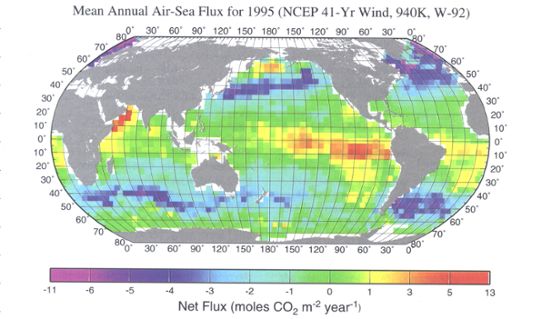Since the middle of the 19th century, human emissions of carbon dioxide have caused the levels in the atmosphere to increase from 270 ppm (parts per million) to 410 ppm. In parallel, the average temperature of the earth has increased by almost a whole degree.
Carbon dioxide is one of the most important greenhouse gases and a significant part of global warming can be attributed to the increased levels of carbon dioxide in the atmosphere. If the oceans’ absorption had not increased then the levels in the atmosphere would be about 50 ppm higher.
However the relative proportion of human emissions absorbed by the ocean seems to be decreasing. According to the latest estimate from the IPCC, a carbon dioxide level of 460 ppm would lead to an average temperature several tenths of a degree higher than today.
A complex process
The absorption of carbon dioxide by the sea is a complicated process that is dependant on the difference in the in concentration of carbon dioxide between the sea surface and the air, and the efficiency of the exchange. The concentration in the sea surface depends in turn on the water temperature, mixing, and biological activity in the water.
The efficiency of the exchange is a rather unknown process, but it is assumed to be mainly dependant on the thin layer of the water surface which is in turn affected by the wind speed above the surface.
It would be possible to monitor the exchange of carbon dioxide between ocean and atmosphere, but it requires quite complicated measurements that cannot be carried out everywhere.
The concentration of carbon dioxide in the sea surface is higher around the equator and lower nearer the poles. This means that the sea will emit carbon dioxide to the atmosphere near the equator (between 20ºS and 20ºN) and absorb carbon dioxide further away from the equator.
The areas 35º-50ºS and 35º-50ºN, where there are also strong winds, are efficient at absorbing carbon dioxide. A considerably larger amount of the atmospheric carbon dioxide is absorbed in the northern Atlantic where it is transported down into the deep water.

Failed attempts to influence absorption
Increased absorption of carbon dioxide by the sea has a positive effect on the atmosphere, since it slows down the escalating greenhouse effect. However there are indications that increased absorption of carbon dioxide in the sea would change the pH value of the sea with a tendency towards acidification, which could cause problems for sensitive ecosystems such as coral reefs.
Attempts have been made to artificially increase the sea’s absorption of carbon dioxide. Areas of sea have been fertilised by enriching with iron: however this has not been successful, as there is a large risk of over-fertilisation leading to increased growth of poisonous algae. It can be assumed that the over-fertilisation of for example the Baltic is likely to lead to increased absorption of carbon dioxide.
Attempts have also been made to pump the carbon dioxide into the deep sea waters – but this has not been particularly successful either, since the chemical reactions create too much carbonic acid, leading to dead zones on the sea floor.
Since the world oceans (sea surface and deep sea) constitute such a large reservoir of carbon (50 times as much as the atmosphere) and can absorb much more carbon dioxide than the atmosphere, it can be expected that on a time scale of tens of thousands of years the sea will absorb 80-90 % of human carbon dioxide emissions.